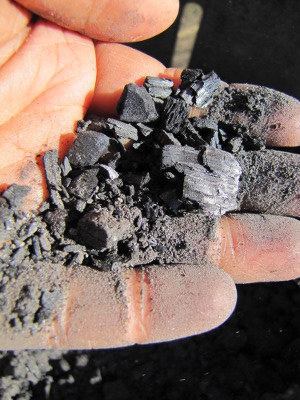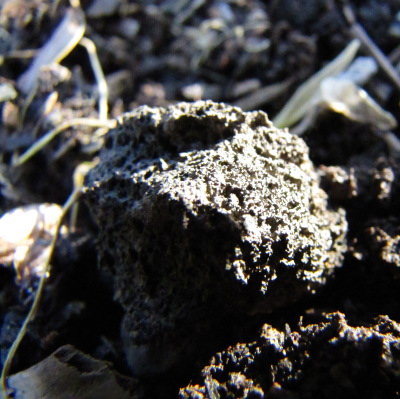
Do I need to crush biochar?
 We've
been collecting
charcoal all winter by screening it out of the ashes in the bottom of
the wood stove,
waiting until I figured out how to crush it before putting the biochar
to use. Large-scale farmers powder their
biochar
so that it's easy to apply with their machinery, but on the small
scale, crushing biochar is a pain.
In fact, from the multitude of questions about how to crush biochar on
forums (and from my own experience), I suspect that the crushing step
is holding a lot of gardeners back using biochar in the garden.
Is it really necessary to grind biochar?
We've
been collecting
charcoal all winter by screening it out of the ashes in the bottom of
the wood stove,
waiting until I figured out how to crush it before putting the biochar
to use. Large-scale farmers powder their
biochar
so that it's easy to apply with their machinery, but on the small
scale, crushing biochar is a pain.
In fact, from the multitude of questions about how to crush biochar on
forums (and from my own experience), I suspect that the crushing step
is holding a lot of gardeners back using biochar in the garden.
Is it really necessary to grind biochar?
The answer is "probably not." Scientists found that biochar
particle sizes ranging from a twelfth of an inch to three quarters of
an inch showed the same effects on crops. In fact, natural
processes in the soil probably break those large particles down into
small particles quite quickly due to freeze/thaw cycles and to plant
roots and fungal hyphae penetrating
the charcoal. Unless you're an industrial-scale farmer who needs
powdered biochar so that it can be applied with your existing
machinery, grinding charcoal probably only speeds up the process by a
couple of months to a year.
I even stumbled across a statement on
a biochar forum that
made
me think we'd be better off using chunky biochar in our soil:
 Since our soil is
already high in clay and needs all the airflow it can
get, it sounds like we should
apply our
biochar in chunk
form. Come to think of it, the healthiest part of our current
garden is the area where the previous residents tossed their stove
ashes, and the chunks of charcoal in the soil there don't seem to be
causing any problems. A few big lumps like this remain after
fifty years, but most of the charcoal has broken down to soil-sized
particles.
Since our soil is
already high in clay and needs all the airflow it can
get, it sounds like we should
apply our
biochar in chunk
form. Come to think of it, the healthiest part of our current
garden is the area where the previous residents tossed their stove
ashes, and the chunks of charcoal in the soil there don't seem to be
causing any problems. A few big lumps like this remain after
fifty years, but most of the charcoal has broken down to soil-sized
particles.
| This post is part of our Biochar in the Backyard lunchtime series.
Read all of the entries: |
Want more in-depth information? Browse through our books.
Or explore more posts by date or by subject.
About us: Anna Hess and Mark Hamilton spent over a decade living self-sufficiently in the mountains of Virginia before moving north to start over from scratch in the foothills of Ohio. They've experimented with permaculture, no-till gardening, trailersteading, home-based microbusinesses and much more, writing about their adventures in both blogs and books.
Want to be notified when new comments are posted on this page? Click on the RSS button after you add a comment to subscribe to the comment feed, or simply check the box beside "email replies to me" while writing your comment.
- Remove comment
